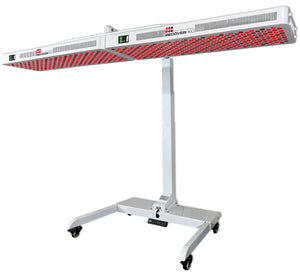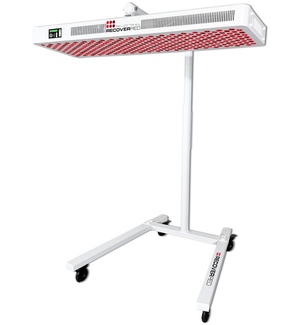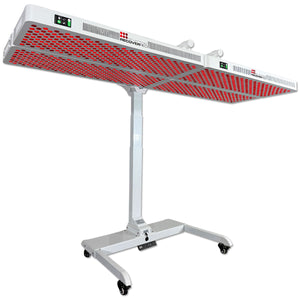Fungal and mold infections can be persistent and bothersome, affecting various parts of the body, from the skin to the nails and even the genitals. Red light therapy, along with its infrared counterpart, has emerged as a potential treatment option for these stubborn conditions. Let's delve into how this therapy can offer relief and aid in the prevention of such infections.

Understanding Infections and Inflammation
Infections can trigger persistent inflammation, causing the affected area to generate scar tissue rather than normal, healthy tissue. This not only hampers the natural healing process but also poses a significant challenge, especially in sensitive areas like the genitals. However, red light therapy has shown promise in tackling these concerns effectively.
Reducing Inflammation with Red Light
One of the primary benefits of red light therapy lies in its ability to reduce inflammation [1]. Typically, infections lead to symptoms such as redness, soreness, and itching as the body's immune system combats the intrusive microorganisms. This intense interaction often results in increased inflammation, fostering the growth of fungi.
While conventional treatments often include anti-inflammatory components, they might only mask the underlying issue. Studies suggest that red light therapy aids in alleviating the metabolic causes of inflammation, allowing cells to produce more energy and CO2, which mimics the effects of anti-inflammatory components. This, in turn, hinders the synthesis of inflammatory mediators and curbs the release of various inflammatory cytokines.
Targeting Fungi and Bacteria with Red Light
Red light therapy's appeal also stems from its direct impact on the destruction of fungi and bacteria. Research indicates that the efficacy is dose-dependent, emphasizing the importance of optimal exposure. Higher doses and longer exposure tend to result in greater bacteria destruction, while lower doses primarily inhibit fungal growth. [2]
Some treatments involve light-sensitive chemicals, known as photodynamic therapy, which, when combined with red light, can amplify the therapy's effects. Additionally, the interaction between red or infrared light and the chemicals within the fungal cells triggers a destructive reaction, eventually eradicating the fungi.
Resolving Recurrent Infections
For those plagued by recurrent infections, red light therapy presents a promising long-term solution. By promoting skin health and bolstering resistance against future infections, this therapy addresses the root causes of these persistent issues [3]. Be it oral candida infections or toenail fungus, studies indicate that red light therapy is particularly effective when administered preemptively, potentially preventing the escalation of minor inflammations into stubborn infections.
Optimizing Light Therapy for Best Results
Research suggests that red light within the 660 – 850 nm wavelength range yields potent anti-inflammatory effects, while infrared light exhibits superior fungicidal properties, particularly suitable for treating deeper fungal infections [4].
Both variations, however, prove equally effective in combating these stubborn infections. Moreover, the dosage and exposure time play crucial roles in achieving desired outcomes, with a higher dose and closer proximity resulting in better results.
Bottomline
Light therapy, whether in the form of red or infrared light, has shown promise in the short- and long-term treatment of fungal infections. Its ability to target and eliminate microorganisms, coupled with its anti-inflammatory properties, highlights its potential in offering relief and preventing the recurrence of these bothersome infections. By harnessing the power of light, we can pave the way for healthier, infection-resistant skin.
At RecoverRed, we specialize in premium red light products designed to harness the therapeutic benefits of red light therapy. Our products are meticulously crafted to help you combat fungal and mold infections effectively, promoting skin health and overall well-being. Discover how our innovative red light solutions can make a difference in your journey toward a healthier, infection-free life.
References:
- Hamblin MR. Mechanisms and applications of the anti-inflammatory effects of photobiomodulation. AIMS Biophys. 2017;4(3):337-361. doi:10.3934/biophy.2017.3.337
- da Silveira, P. V., Panariello, B. H. D., de Araújo Costa, C. A. G., Maule, S. M., Maule, S. M., Janal, M. N., Zanin, I. C. J., & Duarte, S. (2019). Twice-daily red and blue light treatment for Candida albicans biofilm matrix development control. Lasers in medical science, 34(3), 441–447. https://doi.org/10.1007/s10103-018-2610-x
- König, K., Teschke, M., Sigusch, B., Glockmann, E., Eick, S., & Pfister, W. (2000). Red light kills bacteria via photodynamic action. Cellular and molecular biology (Noisy-le-Grand, France), 46(7), 1297–1303.
- Hamblin MR. Mechanisms and applications of the anti-inflammatory effects of photobiomodulation. AIMS Biophys. 2017;4(3):337-361. doi:10.3934/biophy.2017.3.337




